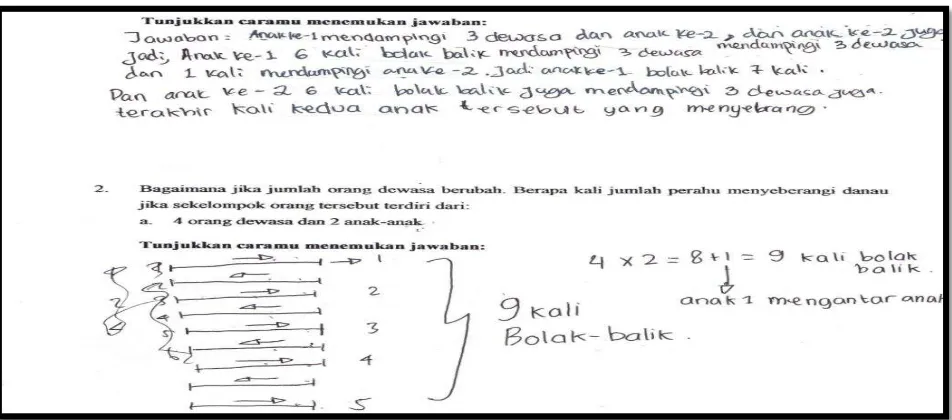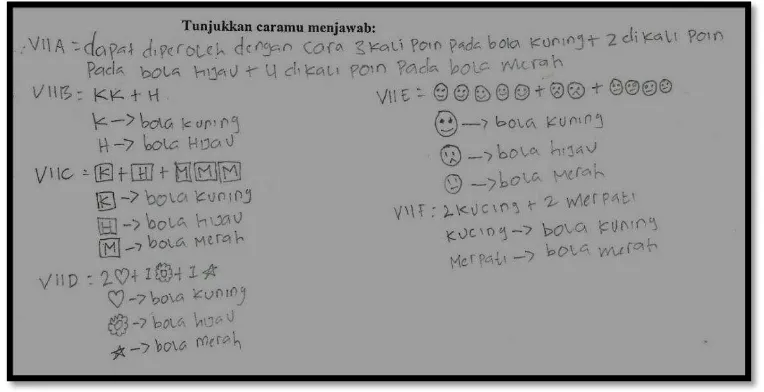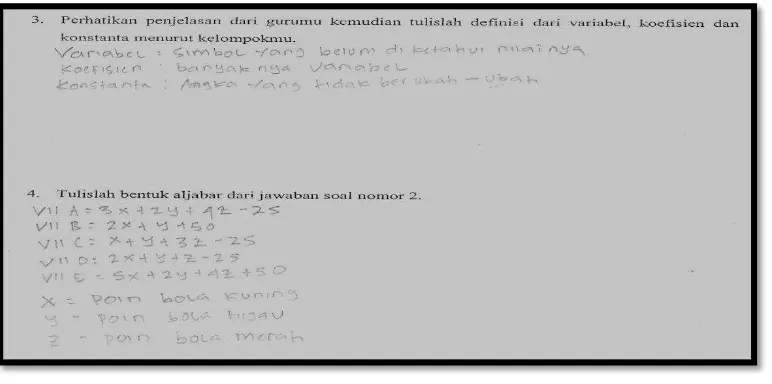DESIGN RESEARCH:
DEVELOPING MATHEMATICAL REASONING ON EARLY ALGEBRA
FOR MIDDLE SCHOOL STUDENTS
Zen Alfiah1, Anton Noornia2, Meiliasari3
State University of Jakarta1, State University of Jakarta2, State University of Jakarta3
1)She_alfie@yahoo.com, 2)Antonnoornia@yahoo.com, 3)Meiliasari@unj.ac.id
Abstract
This paper discusses how to develop mathematical reasoning in early algebra for middle school students. Given the fact that in the first year of middle school, students are in transition from arithmetic thinking to algebraic thinking, most of them are still in the state of arithmetic thinking, thus they have difficulties in understanding algebraic topic. We designed classroom activities to develop student’s mathematical reasoning underpinned by Realistic Mathematics Education (RME). The methodology of this research is design research which consists of three phases; thought experiment, teaching experiment, and retrospective analysis. In tought experiment phase, we designed the classroom activities and made conjectures of students’ learning. The teaching experiment was conducted in grade 7 class of SMP Labschool Jakarta. We collected our data; video recording, students’ work and interviews, and field notes. In the restrospective analysis, we analysed the data. The result shows that pattern activities have support students to find the pattern in a problem, constitute a strategy to simplify the problem by using models and finally make generalization. The social norm in the classroom has helped students to justify their answer, build arguments on the mathematics reasoning process.
Keywords : mathematical reasoning, early algebra, RME.
INTRODUCTION
In Indonesian mathematics school curriculum, algebra is formally introduced in secondary school. Therefore, students are in the transition from arithmetic thinking to algebraic thinking. On learning arithmetic students calculate unknown values while learning algebra students must use reasoning about the unknown value or recognize the difference between the variable and the specific situation and the general situation. We run a trial test to students in grade 7 to find out their reasining skills when working on contextual algebraic problem.
Figure 1 :Algebraic problem in trial test
Mr. Shandy is a manager of a parking lot. He plans to make a parking lot for Dharma Bhakti University. The parking lot will consist of 3 floors, each floor has the same capacity to load the same number of vehicles, that is 150 cars, 300 motorcycles and 350 bicycles. Mr. Shandy wants to calculate the area of land needed for the parking lot.
a. Let’s help Mr. Shandy to find out the area of land needed to make a parking lot
parking lot one floor with building an algebraic expression.
b. Let’s help Mr. Shandy to calculate the area of the car park floor 1 to floor 3 with
The problem asks for student’s understanding of the concept of variables and mathematical reasoning students in constructing an algebraic expressionfrom contextual situation. Only 2 students were able to answer correctly, 37 other students had difficulties in understanding concept of variable.
Here are some of example of student’s strategies:
Figure 2 :Student’s strategies of solving a contextual problem
Based on the trial test, we found out that students still have difficulties in developing mathematical reasoning of algebraic expression from word problems. Even though the teacher has taught the algebraic topic but students still have difficulties in constructing algebraic expression from word problems. Students still have misconceptions about variables, that is students assume the variable is the object. This case was described by Walle(2007) that almost all of student think that variable represent value but actually variable represent value of object. This fact indicates the student is not ready through a period of transition from the arithmetic thingking to the algebraic thingking. Learning algebra in class only introduces symbols in algebra and algorithms without students knowing the meaning of the symbol.
Learning algebra using contextual situation enable students to develop mathematical reasoning so as to pass transition from arithmetic thinking to algebraic thinking. PendidikanMatematikaRealistik Indonesia (PMRI) is the Indonesian adaptation of the Dutch Realistic Mathematics Education (RME) application of an approach suitable for developing mathematical reasoning. We posed the following question to be answered through research design: How to develop mathematical reasoning on early algebra for
THEORITICAL FRAMEWORK
Realistic Mathematics Education (RME)
Pendidikan Matematika Realistik Indonesia is the Indonesian adaptation of the Dutch Realistic Mathematics Education (RME). Freudenthal revealed that "mathematic is a human activity". Mathematics as activity or process, Freudhenthal does not put mathematics as finished product. Freudenthal suggested that mathematics should not be taught as finished product but as students’ activity that supports the construction of mathematical concepts. In Education Realistic, realistic problems are used as a foundation for building a mathematical concept or referred to as a source for learning . Gravemeijer in Sembiring (2008) said: "There are three basic tenets of RME items, namely guided reinvention, didactical phenomenology models and the mediating principle". At first principles which are guided rediscovery use works mathematician who had invented the concept of formal mathematics instruction so that students as early as rediscovered mathematical concepts. The next principle is that didactic phenomenology found the problem or situation that allows to generalize mathematical concepts that can be the basis for mathematical problem solving. The last principle is mediation model which describes the role of mathematics as a bridge between the informal to the formal mathematics mathematics.
Treffers (1987) defines five characteristics of Realistic Mathematics Education, namely: The use of context, the use of the model for progressive matematisasi, utilization of construction students, interactivity, relevance. Through the use contextual situation, the students are actively involved issues exploratory activities. Exploration of students not only aims to find the final answer of the given problem but also aimed to develop problem-solving strategies that have been used. The use of context requires their own reasoning to finding ideas or ideas in solving contextual problems.
The second characteristic is the use of the model. Gravemeijer (2002) found in this model can be used as strategies to solve the problem of human activity. Gravemeijer also revealed that there are 2 kinds of models in RME:
At first a model is constituted as a contextspecific model of acting in a situation, then the model is generalized over situations. The model changes character, it becomes an entity of its own, and as such it can function as a model for more formal
mathematical reasoning .
Based on Gravemeijer’s 2002 opinion the model is divided into two kinds of models (model of) contextual situations that generalize the situation. The next model is a model for to the formal mathematics. In the process of moving towards a model of the model to require mathematical reasoning. The function of the model is to serve as a model of using formal mathematical reasoning.
to each other through social interaction. The fifth characteristic is the intertwining, the mathematical concepts are not to be partial, every topic have relevance . Through this connection, the study is expected to introduce mathematics and build more than one at the same mathematical concepts. Intertwining helps student to show the relevance of learning issues that will be studied with other related learning issues and relevance to the daily lives of students .
Learning Algebra
Angel (2007) described that the word algebra comes from the Arabic as "Al-jabr" which means as "reunion of broken parts", based on the book written by a mathematician that Muhammed ibn Musa Al-Khwarizmi-year AD 825 Algebra uses letters of the alphabet is called a variable to represent the value. For example, the letters x and y are commonly used to indicate variables while the symbol that indicates a specific value called constants. Algebra is an important topic according Kaput, because:
(1) Algebra is the language of generalization, (2) Algebra enables a person to
answer all the question of a particular type at one time,(3) Algebra is the language of relationship between quantities,(4) Algebra is the language for solve certain kind of numerical problem.
Based on the opinions of Kaput (Zalman, 1995), Algebra is the simple language of a pattern. Algebra denotes the relationship between objects so that it allows us to answer many questions using a model in one time. Algebra facilitates in solving numeric problems. This suggests that algebra is an important topic that is taught in schools. According to the National Council of Teachers of Mathematics (2000) the standard that should be on teaching algebra in schools include: (1)Understand patterns, relations, and
function, (2) Represent and analyze mathematical situations and structures using
algebraic symbols, (3) Use mathematical models to represent and understand quantitative
relationships, (4) Analyze change in various contexts.
Teaching algebra in schools should include the NCTM standards. At the beginning of the learning students are expected to recognize a pattern, relations and functions. In the next stage the students analyze the situation using a structured symbol then use a mathematical model to understand the interrelationships between some quantity. Students also have to investigate the truth of the allegations that they have found that whose truth has been proved or assumed before".
Shadiq(Wardhani, 2004) emphyzises on the process of mathematical reasoning or thinking activity. The reasoning process happens when students make conjectures, then prove their conjectures and make a conclusion.
reasoning and methods of proof . Mathematical reasoning more than teaching mathematical reasoning using formal mathematical procedural route but rather encourage students to discover the connection of learning mathematics
Sonnabend (2010) explained that there are two kinds mathematical reasoning namely inductive reasoning and deductive reasoning. )nductive reasoning is the process of making a generalization based on a limited number of observation or example . Inductive reasoning is the process of making conclusions based on the examples that the student collecting. Inductive reasoning is used to investigate the truth of a pattern or rule that is already known. In this case inductive reasoning is generalization from some
particular cases to the general conclusion. Sonnabend describes that : Deductive
reasoning is the process of reaching conclution from given fact or hypotheses . Deductive reasoning is the process to reach a conclusion exclusively based on the facts or hypotheses. Deductive reasoning is the conclusion of a general nature to the conclusions specifically.
METHOD
The research used a design research methodology. Gravemeijer and Cobb (2006) explained that design research consists of cycles which have three phases: (1)Thought
Experiment, (2) Teaching Experiment (3) Retrospective analysis. In tought experiment
phase, we designed the classroom activities and made conjectures of students’ learning. The teaching experiment was conducted in one class at grade 7 class of SMP Labschool
Jakarta that consist 38 students. We collected our data; video recording, students’ work
and interviews, and field notes. In the restrospective analysis, we analysed the data.
RESULT AND DISSCUSSION
Lesson 1: Finding and building patterns
In the first lesson, the students were given a contextual situation that allows students made a pattern. We develop this contextual problem based on the research by Hebert and Brown (1997). The problem is ; there is a group of people consists of 2 children and 6 adults. They will cross a river, but there is only one boat that can only load 1 adult, 1 adult and 1 child or 2 children.
Students were asked to find the number of trips needed to transport all passengers.
Students were instructed to find the the number of trips needed to transport all passengers and if the number of the adults are 4, 8 or 5, while the number of children remain.
The situation allows the students to describe a variety of strategies to solve problems. Students establish conjecture that enable to solve the problem and investigate validity of
Figure 3 : Group A strategies to find pattern
The figure shows that the students in group A made a model of to represent contextual
situation. They drew the passengers and drew the lines to represent the number of trips. Based on this drawing, the students was able to find the pattern. First, they bring 1 adult and 1 child, then the child go back, bring another child and another adult and so on. They got 13 times crossing the river to bring 6 adult and 2 children. They found the pattern; that to bring 1 adult they needed 2 trips crossing the river and the last trip to bring 2 children. They found the number of trips needed from the number of adult multiply by 2 and add by 1. This pattern also applies to take across 4 adults and 2 children 9 times as many crossings. From generalizing pattern, students come to understand the power of algebraic thinking.
Another student’s strategies:
The figure shows that group B made a model of to represent contextual situation. They wrote their own word to represent the contextual situation. They found the pattern without drawing before, they made the conjecture that first child takes 3 adult and second child also takes 3 adults so first child crossing the river 6 times and second adult crossing the river 6 times. The trip takes 2 children croosing the river, so they got 13 trips crossing the river to bring all passanger. They also drew lines to represent the number of trips and they got 9 trips to bring 4 adults and 2 children. They made a conjecture before proving the conjecture with drawing lines. Students found the pattern as power to algebraic thinking.
Lesson 2: Aims to build the understanding of the meaning variable, coefficient and constant.
In the second lesson the students worked on contextual problem and they use symbols as strategy to solve the problem.
Table below shows the score of each class from the first round:
Class Yellow Ball Green Ball Red Ball
VII A 3 2 4
VII B 2 1 0
VII C 1 4 3
VII D 2 1 1
VII E 7 2 4
VII F 2 5 2
Students were instructed to find how many points each class gets in the friest round. In this problem, different colours of ball represent different value. This evokes students to use symbol as strategy to solve the problem.
Based on the figure, group C made model of situation by writing with their word and made symbol to represent the balls. At the begining, they wrote with their word that counting point by multiply value of yellow ball by 3 add with multiply point of green ball multiply by 2 add multiply point of red ball multiply by 4 then they changed their word by symbol but they still have misunderstanding about the symbol that they made. Students think that the symbol represent object not value. The teacher confirmed that the symbol represent value not object. The teacher instructed the students to change their symbol with letter of alphabet to represent value. Angel (2007) described that algebra uses letter of the alphabet called variables to represent numbers.
Students began to understand the concept of coefficient when they wrote the number of the ball. Students were no longer drawing three hearts to represent 3 yellow balls but they draw one heart and wrote 3 in front of the heart. The teacher confirmed that the numbers of variables is called coefficient. Wardhani (2004) described that coefficient is part of algebra represent the number of variable.
On the next problem, students were instructed to calculate the point of each class if given this rules: adding 50 points for any correct answer, and subtracting 25 points for any wrong answer. Result : class of VII B dan VII E have correct answer and class of VII A, VII C and VII D false answer. By this rules student begining to understand concept of constant.
Figure 5 : Group C strategy to found the concept of constant
Figure 6 : Students able to write algebra expression
Teacher as fasilitator instructed to students for changing their symbol with algebra expression. These activities has enable students to build an understanding of the concept of variable, coefficient and constan then students able to write algebra expression.
CONCLUSION
Through out the activities, students develop an ability to seek patterns, recognize the pattern and generalize the pattern based Hebert and Brown (1997) this is foundation of algebraic thinking. Student use symbol to represent different values in the given contextual problems. The symbols helped students build understanding on the meaning of variable, coefficient and constant. Moreover, they were able to write the formal algebraic expression.
The results of this research shows that using contextual problem support students to develop mathematical reasoning. Student can solve this problem with their own reasoning. Students are able to pass through the transition from arithmetic thingking to the algebraic thingking by developing mathematical reasoning stimulated by the contextual situation. By contextual problem, students able to built algebra expression from word problems.
This research has not been able to represent all of the students answer because it only uses 6 students as research subjects. However, this study may open new information regarding the application of RME theory in the learning of algebra.
REFERENCES
Angel, A.R. (2007). Survey of Mathematics with Applications. USA:Pearson.
Hebert,K, & Brown, R.H . (1997). Pattern As Tool For Algebraic Reasoning. Teaching
Children Mathematics,(February,1997). 340-345. USA:NCTM
Gravemeijer, K. P. E., & Cobb, P. (2006). Design research from a learning design perspective, In J. Van Den Akker, K. Gravemeijer, S. McKenney, & N. Nieveen (Eds.), Educational Design Research (pp. 17-51). New York: Routledge
National Council of Teachers of Mathematics. (2000). Principles and Standarts for School Mathematics. Reston,VA : Author.
Sembiring, K, Hadi,S, & Solk,M. (2008). Reforming Mathematics Learning in Indonesian
Classrooms Through RME. Indonesia, ZDM The International Journal on
Mathematics Education Vol 40. 927–939
Sonnabend, T. (2010). Mathematics For Teachers, Fourth Edition. Canada:Brooks/Cole.
Walle, J.A.V. (2007). Elementary and Middle School Mathematics : Teaching
Developmentally. Ontario: Pearson Education Canada Inc.
Wardhani,M.Pd , Sri. (2004). Permasalahan Kontekstual Mengenalkan Bentuk Aljabar di SMP.Paket Pembinaan Penataran. Yogyakarta:Departement Pendidikan Nasional Direktorat Jendral Pendidikan Dasar Menengah Pusat Pengembangan Penataran Guru Matematika.
Wijaya, A. (2012). Pendidikan Matematika Realistik Suatu Alternatif Pendekatan Pembelajaran Matematika .Yogyakarta: Graha Ilmu.



